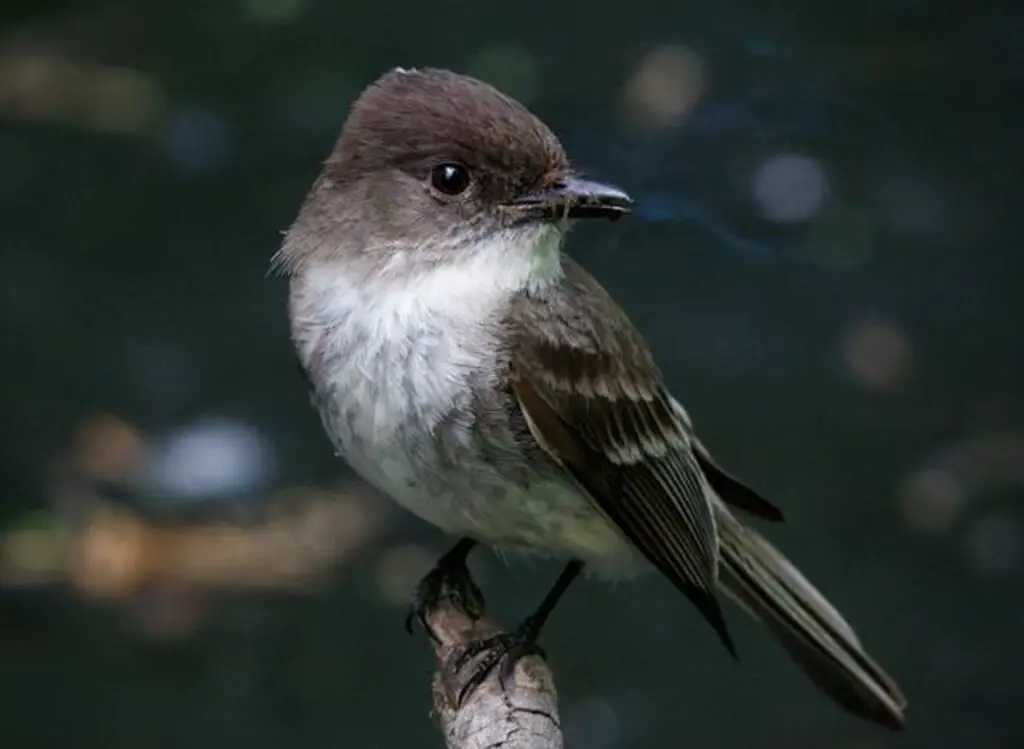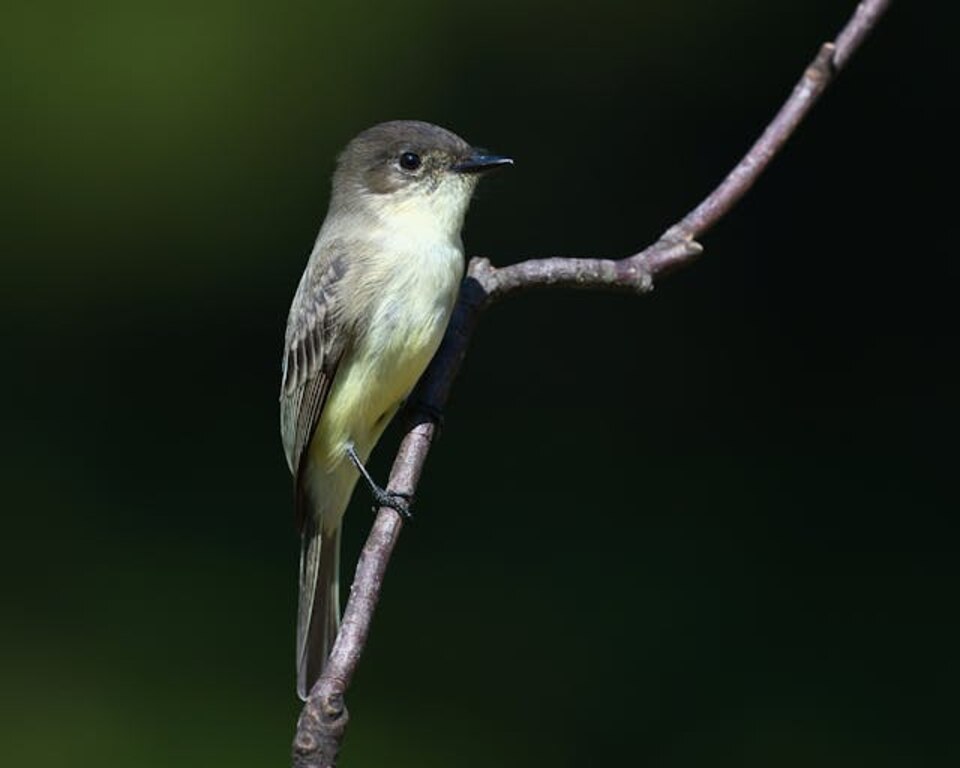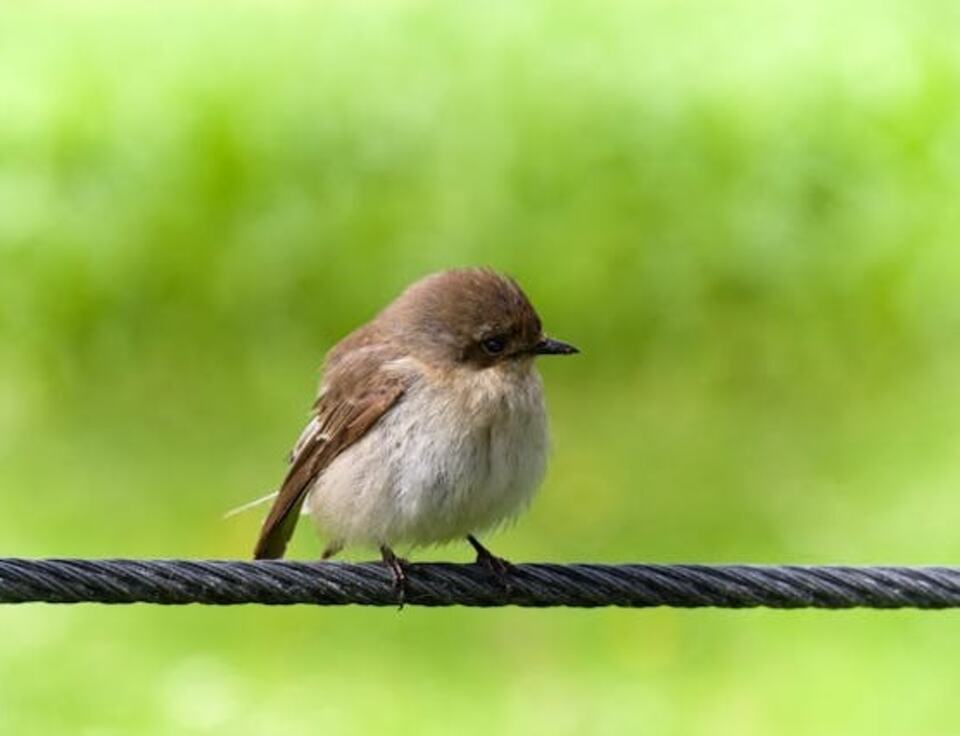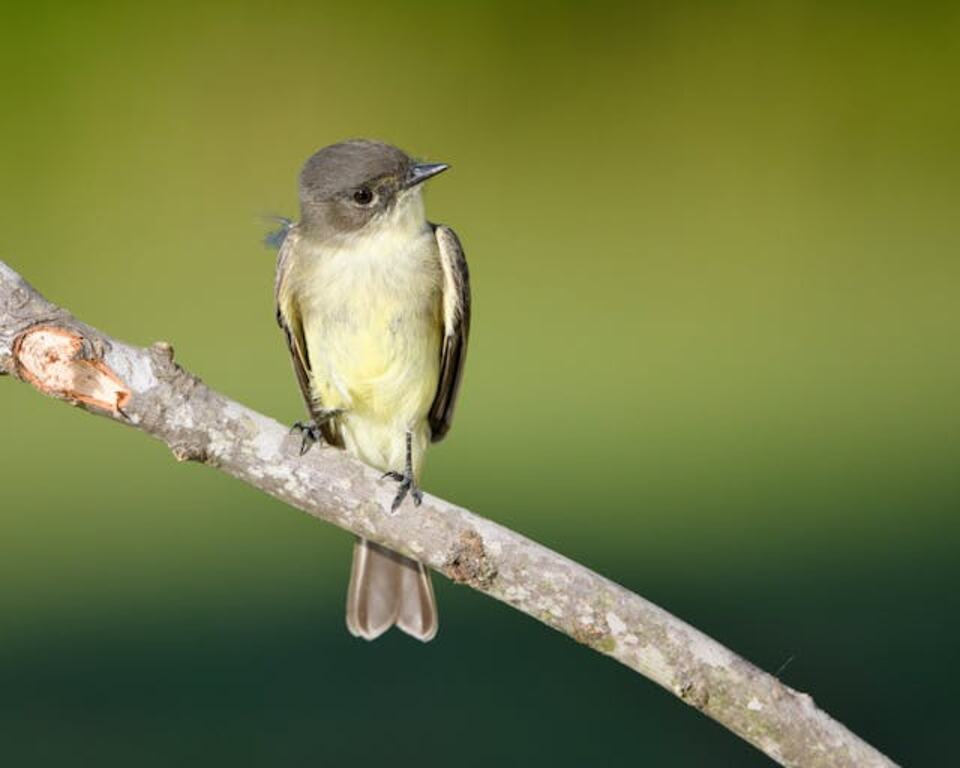The Eastern Phoebe (Sayornis phoebe) is a charming and beneficial bird that can bring life and natural pest control to your garden. Known for its distinctive “fee-bee” call and tail-wagging behavior, this small flycatcher is a joy to observe and a valuable addition to any outdoor space.
In this comprehensive guide, we’ll explore everything you need to know about attracting eastern phoebes to your garden, from understanding their habits and preferences to creating the perfect habitat that will make them want to call your yard home.
Table of Contents
Understanding the Eastern Phoebe
Before we dive into the specifics of attracting eastern phoebes, it’s essential to understand these fascinating birds and their natural behaviors. This knowledge will help you create an environment that caters to their needs and preferences.
Physical Characteristics
Eastern phoebes are small songbirds, measuring about 6.3 inches (16 cm) in length with a wingspan of approximately 10.2 inches (26 cm). They have a distinctive appearance that sets them apart from other flycatchers:
- Coloration: Overall grayish-brown above and off-white below
- Head: Large head with a slightly darker cap
- Bill: Short, broad, and dark-colored
- Wings: Dark with subtle wing bars
- Tail: Long and often pumped up and down while perched
One of the most endearing characteristics of the eastern phoebe is its habit of constantly wagging its tail while perched. This behavior, along with their unique call, makes them easy to identify even for novice birdwatchers.
Range and Migration Patterns
Eastern phoebes are found throughout eastern and central North America. Their breeding range extends from central Canada southward to the eastern United States, reaching as far west as eastern Texas and the eastern edges of the Great Plains. During winter, they migrate to the southeastern United States, Mexico, and parts of Central America.
Understanding their migration patterns is crucial for attracting these birds to your garden:
- Spring arrival: Eastern phoebes typically return to their breeding grounds in March or early April, making them one of the earliest returning migratory birds.
- Fall departure: They begin their southward migration in September or October, with most birds leaving by November.
By knowing when to expect eastern phoebes in your area, you can prepare your garden to be an attractive stopover or breeding site for these birds.
Habitat Preferences
In their natural environment, eastern phoebes prefer open woodlands, forest edges, and areas near water. They are often found near human structures, which they frequently use for nesting. Some key habitat features that attract eastern phoebes include:
- Open areas: For foraging and insect-catching
- Perches: Exposed branches or wires for hunting and resting
- Water sources: Streams, ponds, or birdbaths for drinking and bathing
- Nesting sites: Protected ledges, bridge supports, or building eaves
By incorporating these elements into your garden design, you can create an inviting environment for eastern phoebes.
Creating the Perfect Phoebe Habitat
Now that we understand the basic needs and preferences of eastern phoebes, let’s explore how to transform your garden into a phoebe paradise. By focusing on key aspects of their habitat, you can increase the likelihood of attracting these delightful birds to your outdoor space.
Landscaping for Phoebes
The layout and plant selection in your garden play a crucial role in attracting eastern phoebes. Here are some landscaping tips to create an ideal phoebe habitat:
Open Areas
Eastern phoebes require open spaces for foraging and catching insects on the wing. To accommodate this need:
- Create clearings: Leave some areas of your garden open and free from dense vegetation.
- Maintain lawn spaces: Keep portions of your lawn mowed to provide hunting grounds for phoebes.
- Incorporate pathways: Garden paths can serve as excellent open corridors for phoebe activity.
Native Plants
While eastern phoebes primarily feed on insects, incorporating native plants in your garden can attract a variety of insects that serve as food sources. Some beneficial native plants include:
- Goldenrod (Solidago spp.)
- Aster (Symphyotrichum spp.)
- Joe-Pye Weed (Eutrochium spp.)
- Coneflower (Echinacea spp.)
- Black-Eyed Susan (Rudbeckia hirta)
These plants not only provide food for insects but also add beauty and diversity to your garden.
Trees and Shrubs
Incorporate a mix of trees and shrubs to provide perching spots and nesting materials:
- Deciduous trees: Maples, oaks, and birches offer excellent perching opportunities.
- Evergreens: Pines and spruces provide year-round shelter and nesting materials.
- Native shrubs: Serviceberry, dogwood, and viburnum offer additional perching spots and attract insects.
Water Features
Water is a crucial element in attracting eastern phoebes to your garden. These birds require water for drinking and bathing, and the presence of water often attracts insects, their primary food source. Consider incorporating the following water features:
Birdbath
A simple birdbath can be highly effective in attracting phoebes. Keep these points in mind:
- Shallow depth: Ensure the water is no more than 1-2 inches deep.
- Moving water: Add a dripper or small fountain to create movement, which attracts birds.
- Regular cleaning: Clean and refill the birdbath frequently to maintain water quality.
Small Pond or Water Garden
If space allows, consider installing a small pond or water garden. This feature can provide a more natural water source and attract a variety of insects for phoebes to feed on. When creating a pond:
- Include shallow areas: Ensure there are gently sloping edges for easy access.
- Add native aquatic plants: These will help maintain water quality and attract insects.
- Incorporate rocks or logs: Place these near the water’s edge to serve as perches for phoebes.
Nesting Sites
Providing suitable nesting sites is crucial for attracting breeding pairs of eastern phoebes. These birds have a unique nesting behavior, often preferring human-made structures. Here are some ways to create attractive nesting options:
Nesting Shelves
Install open-fronted nesting shelves under the eaves of buildings, on covered porches, or beneath deck overhangs. When creating nesting shelves:
- Size: Aim for a platform about 6 inches wide and 6 inches deep.
- Height: Place the shelf at least 8 feet above the ground.
- Protection: Ensure the shelf is protected from direct sunlight, wind, and rain.
Barn-Style Birdhouses
While eastern phoebes don’t typically use enclosed birdhouses, they may nest in barn-style houses with one or more open sides. When selecting or building a barn-style birdhouse:
- Dimensions: Use a base of about 6 inches by 6 inches, with a height of 6-8 inches.
- Entrance: Leave one or more sides completely open.
- Roof: Ensure a slightly sloping roof to shed rain.
Natural Ledges
Create natural-looking ledges by attaching flat stones or boards to the sides of buildings or garden structures. These can mimic the cliff ledges that phoebes sometimes use in their natural habitats.
Feeding Eastern Phoebes
Unlike many backyard birds, eastern phoebes are not typically attracted to seed feeders. Their diet consists primarily of insects, which they catch on the wing or glean from vegetation. However, there are ways to support their feeding habits and ensure a steady food supply in your garden.
Insect-Friendly Gardening
To attract the insects that phoebes feed on, consider the following gardening practices:
Avoid Pesticides
Eliminate or significantly reduce the use of pesticides in your garden. These chemicals not only harm beneficial insects but can also be toxic to birds that consume contaminated prey.
Create Insect Habitats
Incorporate features that attract and support insect populations:
- Leaf litter: Leave some areas of your garden undisturbed with fallen leaves and plant debris.
- Dead wood: Keep dead tree stumps or logs in your garden as they provide habitat for many insects.
- Insect hotels: Create or purchase insect hotels to provide nesting sites for solitary bees and other beneficial insects.
Night-Lighting
Install low-wattage outdoor lighting to attract night-flying insects, which can become food for phoebes during early morning hours.
Supplemental Feeding Options
While not necessary, you can occasionally offer supplemental food to support phoebes, especially during harsh weather conditions or when insects are scarce. Some options include:
- Mealworms: Offer live or dried mealworms on a flat tray or platform feeder.
- Suet: Provide small pieces of suet or suet pellets, which can be especially helpful during colder months.
- Fruit: Occasionally offer small pieces of fresh fruit, such as berries or chopped apples.
Remember that these supplemental foods should not replace the phoebe’s natural insect diet but can serve as an occasional treat or emergency food source.
Maintaining a Phoebe-Friendly Garden
Attracting eastern phoebes to your garden is just the first step. To ensure they continue to visit and potentially nest in your yard, it’s important to maintain a safe and welcoming environment. Here are some key considerations for long-term phoebe hospitality:
Garden Maintenance
Proper garden maintenance can help create a sustainable habitat for phoebes while keeping your outdoor space healthy and attractive.
Pruning and Trimming
- Timing: Avoid major pruning during the breeding season (spring to early summer).
- Selective pruning: Maintain some dense vegetation for shelter while keeping open areas for foraging.
- Perch preservation: Leave some dead branches on trees to serve as hunting perches.
Lawn Care
- Reduced mowing: Allow some areas of your lawn to grow longer, providing habitat for insects.
- Natural fertilizers: Use organic fertilizers to avoid harmful chemicals that can affect insect populations.
Weed Management
- Manual removal: Hand-pull weeds instead of using herbicides.
- Native plant focus: Emphasize native plants that are adapted to your local environment and support local insect populations.
Seasonal Considerations
Eastern phoebes have different needs throughout the year. Adapting your garden management to these seasonal changes can help support phoebes year-round.
Spring
- Nesting material: Provide natural nesting materials like moss, grass clippings, and animal fur.
- Insect boost: Allow early spring weeds to flower, providing food for emerging insects.
Summer
- Water availability: Ensure consistent access to fresh water during hot months.
- Shade: Maintain shaded areas near water sources and potential nesting sites.
Fall
- Migration support: Keep water features clean and accessible for migrating phoebes.
- Seed heads: Leave some flowers to go to seed, providing food for insects.
Winter
- Shelter: Maintain evergreen vegetation and brush piles for overwintering insects.
- Supplemental food: Offer mealworms or suet during harsh weather conditions.
Predator Management
While it’s important to maintain a natural balance in your garden ecosystem, you can take steps to protect phoebes from common predators:
- Cats: Keep domestic cats indoors or supervise them when outside.
- Raccoons and squirrels: Place nesting shelves in locations that are difficult for these animals to access.
- Hawks: Provide dense shrubbery as cover for phoebes to escape from aerial predators.
Nest Box Maintenance
If you’ve installed nesting shelves or barn-style birdhouses, proper maintenance is crucial:
- Annual cleaning: Clean nesting structures in late winter before the breeding season begins.
- Parasite control: Remove old nesting material and treat the structure with a mild bleach solution to eliminate parasites.
- Repairs: Check for and repair any damage to ensure the structure remains safe and weatherproof.
Observing and Appreciating Eastern Phoebes
Once you’ve successfully attracted eastern phoebes to your garden, take time to observe and appreciate these fascinating birds. Not only is birdwatching a rewarding hobby, but your observations can also contribute to citizen science projects and bird conservation efforts.
Birdwatching Tips
To fully enjoy the presence of eastern phoebes in your garden:
- Learn their calls: Familiarize yourself with the distinctive “fee-bee” call of the eastern phoebe.
- Observe behavior: Watch for their characteristic tail-wagging and aerial insect-catching maneuvers.
- Use binoculars: A good pair of binoculars can enhance your viewing experience without disturbing the birds.
- Keep a journal: Record your observations, including arrival dates, nesting activities, and interesting behaviors.
Photography
Capturing images of eastern phoebes can be a rewarding way to document their presence in your garden:
- Use a zoom lens: This allows you to photograph the birds without approaching too closely.
- Set up a blind: A simple photography blind can help you get closer without disturbing the birds.
- Be patient: Wait for the perfect moment when the phoebe is perched or engaged in interesting behavior.
Citizen Science Participation
Your observations of eastern phoebes can contribute to scientific research and conservation efforts. Consider participating in citizen science projects such as:
- eBird: Report your phoebe sightings to this global database of bird observations.
- NestWatch: If phoebes nest in your garden, you can contribute valuable data on their breeding success.
- Project FeederWatch: While phoebes don’t typically visit feeders, you can still report their presence in your yard during the winter months.
Conclusion
Attracting eastern phoebes to your garden is a rewarding endeavor that not only brings joy and natural beauty to your outdoor space but also contributes to the conservation of these charming birds. By understanding their needs and preferences, creating a suitable habitat, and maintaining a phoebe-friendly environment, you can transform your garden into a haven for these delightful flycatchers.
Remember that patience is key when attracting any wildlife to your garden. It may take time for eastern phoebes to discover and become comfortable in their new habitat. Continue to make improvements and maintain your garden with their needs in mind, and you’ll likely be rewarded with the sight and sound of these fascinating birds.
As you enjoy the company of eastern phoebes in your garden, take a moment to appreciate the role you’re playing in supporting local biodiversity. Your efforts not only benefit these individual birds but also contribute to the larger ecosystem and the conservation of bird species as a whole.
By sharing your experiences and knowledge with others, you can inspire more people to create wildlife-friendly spaces, further expanding the network of habitats available to eastern phoebes and other native birds. Whether you’re a seasoned birder or just beginning your journey into the world of backyard bird-watching, the presence of eastern phoebes in your garden is sure to bring endless fascination and a deeper connection to the natural world around you.






